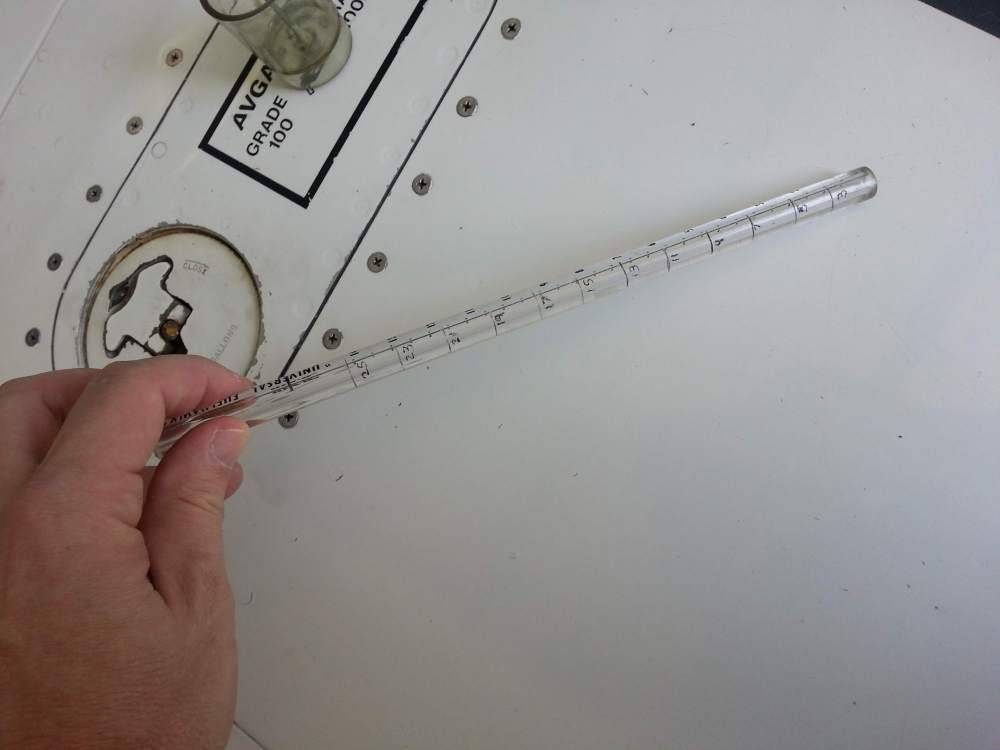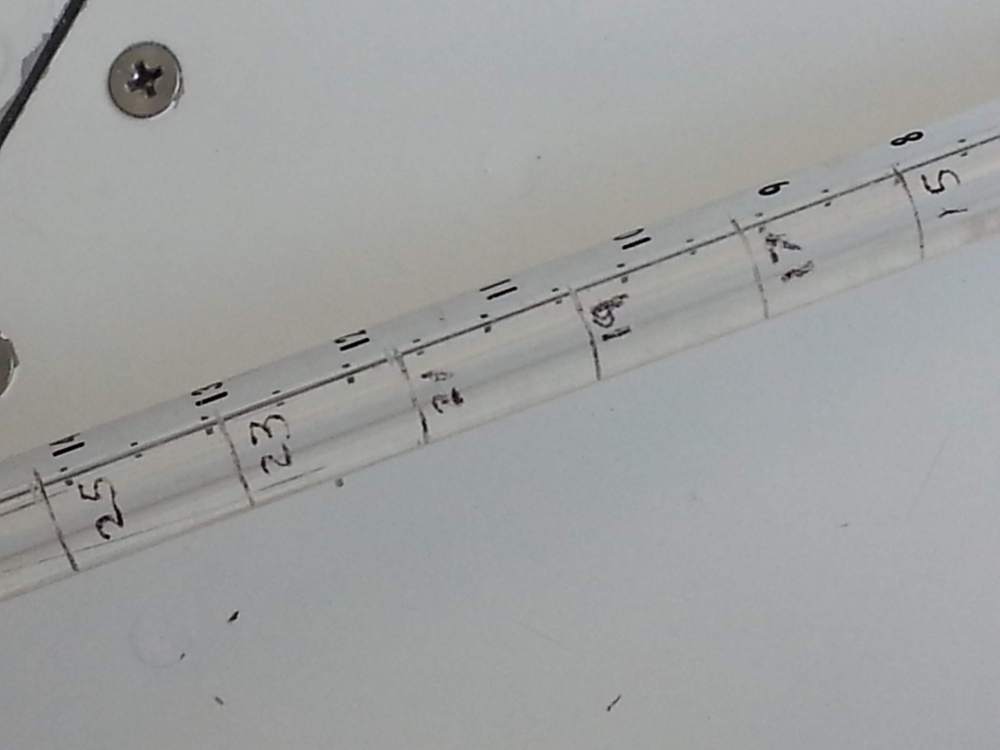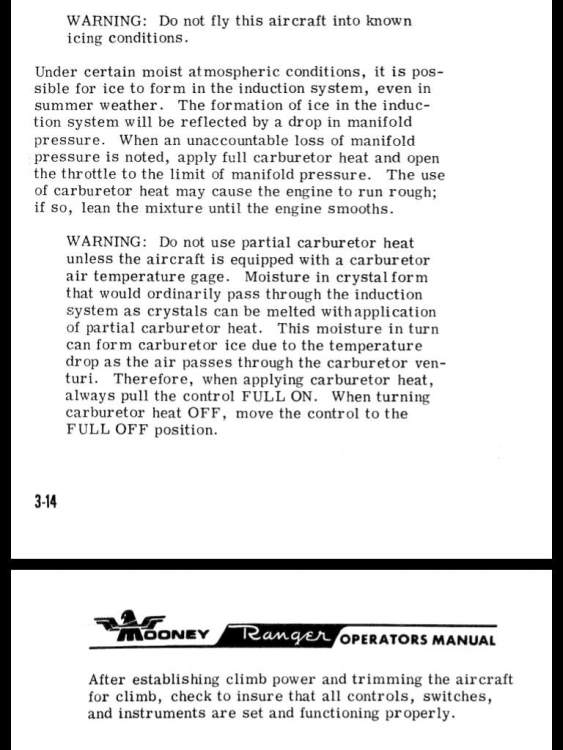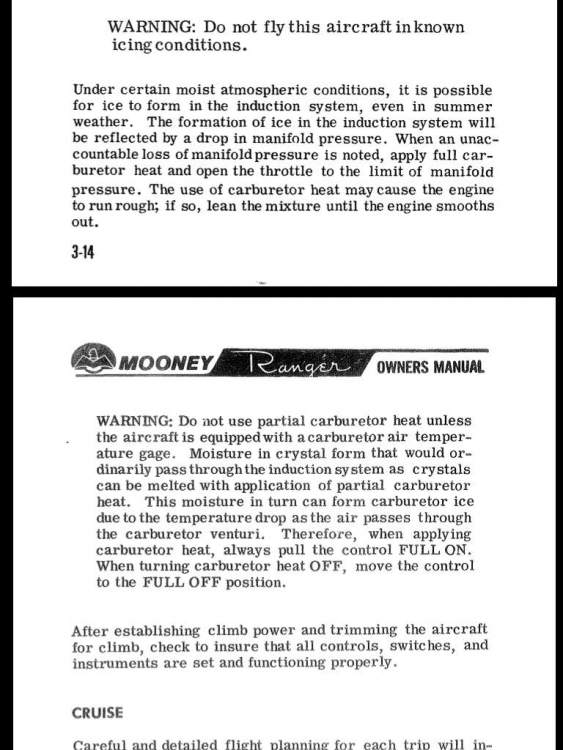-
Posts
19,834 -
Joined
-
Last visited
-
Days Won
119
Content Type
Profiles
Forums
Blogs
Gallery
Downloads
Media Demo
Events
Everything posted by Hank
-
No good photo, but my 1970 C with 201 windshield has a 2-piece glareshield, what looks like the original one that screws on top of an extension going forward to the windshield.
-
You'll get good use from a C. We love ours! Going into the 11th great year.
-
-

Physics Question in Making a Fuel Stick
Hank replied to M20F-1968's topic in Vintage Mooneys (pre-J models)
Mark with a Sharpie, then use a Dremel engraver. The same one you clean your plugs with, but with a smaller tip. Once it's in the plastic, it will never come off . . . . . even if you want it to . . . . Disclosure: the dipstick came with the plane, which I bought in 2007. Never done anything to the stick except use it and put it back on the hatrack. Is that long-lasting enough? -
I pee inside before my flight, and often afterwards. 3-4 hours isn't a problem unless I drink too much coffee first.
-
It's been a while since I was last at Pike County, but it also has a drop off like that at one end, doesn't it? Though it's plenty long.
-

Physics Question in Making a Fuel Stick
Hank replied to M20F-1968's topic in Vintage Mooneys (pre-J models)
-

Physics Question in Making a Fuel Stick
Hank replied to M20F-1968's topic in Vintage Mooneys (pre-J models)
My dip tube last week read 16 gal. Filled that tank up with 10 gal, to rated 26 gal capacity. At reseal, it took 52.3 to fill both from empty. I dip approximately in the center of the cap opening. -

Physics Question in Making a Fuel Stick
Hank replied to M20F-1968's topic in Vintage Mooneys (pre-J models)
It has to do with surface tension. Gravity pulls the fuel inside the tube down, resisted by the surface tension at the bottom combined with the vacuum formed at the top where your thumb seals it. If the column of liquid is too large, surface tension at the bottom can't hold, the surface breaks and it all comes down rapidly. P.S.-- my dip tube is about 1/8" ID, with about thecsame wall thickness. Surface tension is a pretty weak force. -
Wow! Congratulations! It's a wonderful plane. I'm jealous . . . .
-
We'll be waiting! Find out this weekend, we will all be watching!
-
If it worried you enough to cancel a trip, it wasn't minor. Glad you found the cause, increased your knowledge and learned for the future. In my C, climb performance is truly pitiful if I forget to raise the gear. Things happen in high workloads, like departing KFXE in IMC, turning out before the tower and climbing into clouds immediately. Then you wonder why you aren't climbing . . . . It's also generally pretty easy to tell when the gear comes up, as it thumps home almost under your seat. But like Anthony said, the thump is louder going down, but I feel it more coming up. Ghe green light always means "Safe for Landing". I throw the switch on downwind, check the switch on base and check the floor indicator on final; this last check on final has saved me a couple of times, especially those times Tower says to "keep your speed up." That got the previous owner once, but it's never blamed on anyone but the PIC . . . .
-
And we're done . . . But NC's problems are far from over yet. ****************** Flight ops in North Carolina by us are ended as of yesterday. Some local folks are continuing on a smaller scale on their own, but we decided that Sunday was a good stopping point for us. We are, after all, a week one disaster response organization. There are jobs better done by trucks, and jobs that a Blackhawk needs to do instead of a civilian airplane. North Carolina is largely into those phases now. We shattered all previous metrics that we used to measure our success on this one. Number of flights, number of volunteers both pilot and non, number of tons delivered; all are records in terms of this organization. Thank you all for making that happen. 517 flights 280,000 pounds of cargo 468 volunteer pilots All of those numbers reached in less time than we spent on Houston last year. Until next time,
-
I took my C to a good grass field this summer; it had been raining for almost a week, and rained all four days that I was there. When we landed and rolled out, turning around without stopping almost bogged down, but full power and relaxing the turn radius kept me (bafely) moving. When it came time to leave on Monday, more rain was forecast for Sunday night. So I flew out Sunday evening to a nearby paved field and had my wife drive 30 minutes to get me. We loaded up and left from there Monday morning between rain showers with no problem. My wet grass, soft field takeoff (solo, less than half tanks, no baggage) was a little longer than normal with Takeoff flaps, while my normal takeoff is No Flaps. After the squishy landing and almost bogging down, I was cautious. I also walked the runway before takeoff, checking water levels and soft spots. It's not something I'd want to do regularly. Just one more thing to consider . . .
-
When samples are reported in whole numbers, yiu are likely to have several repprted with the median value (same numbers of values abive as below), but are unlikely to have any report with the average value, such as 386.73°. But out of 100 samples, there may be several reported at the median value of 382, with 42 higher, 42 lower and 8 right at 382°. Also remember: there are lies, damned lies and statistics.
-
The thing to remember about averages, regardless of what is being averaged, is that fully 50% of the samples will be above average; the other 50% will be below average. On the other hand, Photos #3 & 4 look like the baffling was not cut to size correctly, or else put together wrong. But I'm not an A&P, so whadda I know?
-
Found the Marvel Schleber book! Lots of information and diagrams, troubleshooting, etc. But no mention of carb temp probes . . . . Guess I should put it in the Download section under Engine Reference Manuals. MA-4 Carb Manual.pdf
-
-
I need to backtrack through thus whole thread . . . Yes, the Optional Carb Temp Gage is a wonderful thing. In six years' flying along the Ohio River, I pulled carb heat in flight to get the needle out of the orange stripe twice, both on winter instrument training flights with my CFII (once in the clouds, once below some darkish-gray clouds). Flights in IMC over southern WV, through light snow that didn't stick anywhere I could see, carb temp was fine even if my nerves were not. The 4 years since I moved back South, none at all. This covers almost 700 hours' tach time, more than that in my logbooks. Checking carb heat function is in the Post-Engine Start checklist, but my Owners Manual doesn't say near as much about its use as the 172 manuals when I was getting my PPL. Let's see what I can find . . . Right, not much. Because I am so equipped, I live by the first sentence affer the word "Warning": Do not use partial carburetor heat unless the aircraft is equipped with a carburetor air temperature gage. Although it doesn't explicitly say so, I use enough carb heat to get the needle out of the marked orange stripe, which is in °C while my OAT is in °F . . . . . More later, it's bedtime.
-
I used to take my C into a 2000' grass strip before I relocated. My personal limit was 2 people and half tanks. No trouble taking a 172 there, nor any of the taildraggers based there. Then skydivers moved in, pranged their 182 after running out of gas and bought a C206. So 2000' can be done, and can be done in a Mooney. But can it be done regularly, often, in a J, with a load? I'm not sure, and that's as far as I'll go (because I don't fly a J).
-
RDU was a zoo on Tbursday, I can only imagine what it will be like today (Saturday)!
-
So maybe it's a thing now that installed equipment can be adapted. If my AI fails, I must adapt by using DG, Altimeter and TC instead . . .
-
I thought that if you saw the lights, you could go another 100' but you must see the runway to go lower.
-
The big round ones aimed at both seats are heat. Follow the fat orange tubing on the right, it should go to the heat shroud around the muffler. The eyeball vent is outside air, you can look through the NACA scoop on the cowl and see inside the plane. In my C, the Cabin Vent knob opens a vent in the center below the throttle quadrant. Check your roof scoop, make sure it opens. Then check in flight and make sure air is coming through the round overhead vents (2 in the front, 2 in the back); there are several threads here in fixing the scoop and vent lines. Other than that, just fly high. Yesterday afternoon, despite heavy sweat on the ground, at 8500' I closed the roof scoop, closed the Cabin Vent most of the way and cracked Cabi Heat about a half inch.
-
dp








